Wideband Circularly Polarized Magneto-Electric Dipole Antenna Array with Metallic Walls for Millimeter-Wave Applications
Abstract
:1. Introduction
2. Antenna Design
2.1. Configuration of the CP Element
2.2. Working Mechanism of the CP Element
2.3. Parameter Analysis of the CP Element
2.4. Performance of the CP Element
2.5. Design of Antenna Array
3. Results and Discussion
4. Conclusions
Author Contributions
Funding
Data Availability Statement
Conflicts of Interest
References
- Azar, Y.; Wong, G.N.; Wang, K.; Mayzus, R.; Schulz, J.K.; Zhao, H.; Gutierrez, F.; Hwang, D.D.; Rappaport, T.S. 28 GHz propagation measurements for outdoor cellular communications using steerable beam antennas in New York City. In Proceedings of the 2013 IEEE International Conference on Communications (ICC), Budapest, Hungary, 9–13 June 2013; pp. 5143–5147. [Google Scholar]
- Zhao, Q.L.; Jin, L. Rain attenuation in millimeter wave ranges. In Proceedings of the 2006 7th International Symposium on Antennas, Propagation & EM Theory, Guilin, China, 26–29 October 2006; pp. 1–4. [Google Scholar]
- Deng, C.; Liu, D.; Yektakhah, B.; Sarabandi, K. Series-fed beam-steerable millimeter-wave antenna design with wide spatial coverage for 5G mobile terminals. IEEE Trans. Antennas Propag. 2019, 68, 3366–3376. [Google Scholar] [CrossRef]
- Gao, S.S.; Luo, Q.; Zhu, F. Introduction to Circularly Polarized Antennas; Wiley-IEEE Press: Hoboken, NJ, USA, 2014; pp. 1–28. [Google Scholar]
- Xu, H.; Zhou, J.; Zhou, K.; Wu, Q.; Yu, Z.; Hong, W. Planar wideband circularly polarized cavity-backed stacked patch antenna array for millimeter-wave applications. IEEE Trans. Antennas Propag. 2018, 66, 5170–5179. [Google Scholar] [CrossRef]
- Wu, J.; Cheng, Y.J.; Fan, Y. Millimeter-wave wideband high-efficiency circularly polarized planar array antenna. IEEE Trans. Antennas Propag. 2015, 64, 535–542. [Google Scholar] [CrossRef]
- Wang, Z.; Tu, Z.H. Wideband Circularly Polarized Antenna Array Using three-layer Segmented Patches for Q-band Application. IEEE Antennas Wirel. Propag. Lett. 2022. [Google Scholar] [CrossRef]
- Ji, Z.; Sun, G.H.; Wong, H. A Wideband Circularly Polarized Complementary Antenna for Millimeter-Wave Applications. IEEE Trans. Antennas Propag. 2022, 70, 2392–2400. [Google Scholar] [CrossRef]
- Gan, Z.; Tu, Z.H.; Xie, Z.M.; Chu, Q.X.; Yao, Y. Compact wideband circularly polarized microstrip antenna array for 45 GHz application. IEEE Trans. Antennas Propag. 2018, 66, 6388–6392. [Google Scholar] [CrossRef]
- Wu, Q.; Hirokawa, J.; Yin, J.; Yu, C.; Wang, H.; Hong, W. Millimeter-wave planar broadband circularly polarized antenna array using stacked curl elements. IEEE Trans. Antennas Propag. 2017, 65, 7052–7062. [Google Scholar] [CrossRef]
- Zhang, L.; Wu, K.; Wong, S.W.; He, Y.; Chu, P.; Li, W.; Gao, S. Wideband high-efficiency circularly polarized SIW-fed S-dipole array for millimeter-wave applications. IEEE Trans. Antennas Propag. 2019, 68, 2422–2427. [Google Scholar] [CrossRef]
- Sadeghi-Marasht, S.; Sharawi, M.S.; Zhu, A. Dual-Band Circularly Polarized Antenna Array for 5G Millimeter-Wave Applications. IEEE Open J. Antennas Propag. 2022, 3, 314–323. [Google Scholar] [CrossRef]
- Zhu, Q.; Ng, K.B.; Chan, C.H. Printed circularly polarized spiral antenna array for millimeter-wave applications. IEEE Trans. Antennas Propag. 2016, 65, 636–643. [Google Scholar] [CrossRef]
- Liu, C.; Guo, Y.X.; Bao, X.; Xiao, S.Q. 60-GHz LTCC integrated circularly polarized helical antenna array. IEEE Trans. Antennas Propag. 2012, 60, 1329–1335. [Google Scholar] [CrossRef]
- Han, W.; Yang, F.; Ouyang, J.; Yang, P. Low-cost wideband and high-gain slotted cavity antenna using high-order modes for millimeter-wave application. IEEE Trans. Antennas Propag. 2015, 63, 4624–4631. [Google Scholar] [CrossRef]
- Wang, X.C.; Xia, Y.J.; Yang, J.H.; Lu, W.Z. Wideband High-Gain Circularly Polarized Substrate Integrated Cavity Antenna Array for Millimeter-Wave Applications. IEEE Trans. Antennas Propag. 2022, 71, 1041–1046. [Google Scholar] [CrossRef]
- Li, Y.; Chen, Z.N.; Qing, X.; Zhang, Z.; Xu, J.; Feng, Z. Axial ratio bandwidth enhancement of 60-GHz substrate integrated waveguide-fed circularly polarized LTCC antenna array. IEEE Trans. Antennas Propag. 2012, 60, 4619–4626. [Google Scholar] [CrossRef]
- Wen, L.; Gao, S.; Hu, W.; Luo, Q.; Yang, X.X.; Sanz-Izquierdo, B. Wideband Differentially-Fed Slot Antenna and Array with Circularly Polarized Radiation for Millimeter-Wave Applications. IEEE Trans. Antennas Propag. 2022, 70, 5418–5429. [Google Scholar] [CrossRef]
- Yang, M.D.; Pan, Y.M.; Sun, Y.X.; Leung, K.W. Wideband circularly polarized substrate-integrated embedded dielectric resonator antenna for millimeter-wave applications. IEEE Trans. Antennas Propag. 2019, 68, 1145–1150. [Google Scholar] [CrossRef]
- Yang, W.W.; Sun, W.J.; Tang, H.; Chen, J.X. Design of a circularly polarized dielectric resonator antenna with wide bandwidth and low axial ratio values. IEEE Trans. Antennas Propag. 2019, 67, 1963–1968. [Google Scholar] [CrossRef]
- Attia, H.; Abdalrazik, A.; Sharawi, M.S.; Kishk, A.A. Wideband Circularly-Polarized Millimeter-Wave DRA Array for Internet of Things. IEEE Internet Things J. 2023. [Google Scholar] [CrossRef]
- Feng, B.; Lai, J.; Chung, K.L.; Chen, T.Y.; Liu, Y. A compact wideband circularly polarized magneto-electric dipole antenna array for 5G millimeter-wave application. IEEE Trans. Antennas Propag. 2020, 68, 6838–6843. [Google Scholar] [CrossRef]
- Wu, J.; Huang, Z.; Ren, X.; Wei, E.I.; Wu, X. Wideband millimeter-wave dual-mode dual circularly polarized OAM antenna using sequentially rotated feeding technique. IEEE Antennas Wirel. Propag. Lett. 2020, 19, 1296–1300. [Google Scholar] [CrossRef]
- Guan, D.F.; Ding, C.; Qian, Z.P.; Zhang, Y.S.; Guo, Y.J.; Gong, K. Broadband high-gain SIW cavity-backed circular-polarized array antenna. IEEE Trans. Antennas Propag. 2016, 64, 1493–1497. [Google Scholar] [CrossRef]
- Lai, H.W.; Xue, D.; Wong, H.; So, K.K.; Zhang, X.Y. Broadband circularly polarized patch antenna arrays with multiple-layers structure. IEEE Antennas Wirel. Propag. Lett. 2016, 16, 525–528. [Google Scholar] [CrossRef]
- Xu, J.; Hong, W.; Jiang, Z.H.; Zhang, H.; Wu, K. Low-profile wideband vertically folded slotted circular patch array for Ka-band applications. IEEE Trans. Antennas Propag. 2020, 68, 6844–6849. [Google Scholar] [CrossRef]
- Baghernia, E.; Movahedinia, R.; Sebak, A.R. Broadband compact circularly polarized spiral antenna array fed by printed gap waveguide for millimeter-wave applications. IEEE Access 2020, 9, 86–95. [Google Scholar] [CrossRef]
- Jiang, Z.H.; Wu, F.; Yue, T.; Hong, W. Wideband and low-profile integrated dual-circularly-polarized transmit-arrays enabled by antenna-filter-antenna phase shifting cells. IEEE Trans. Antennas Propag. 2021, 69, 7462–7475. [Google Scholar] [CrossRef]
- Yang, Y.H.; Zhou, S.G.; Sun, B.H.; Gao, X.Z. Design of wideband circularly polarized antenna array excited by substrate integrated coaxial line for millimeter-wave applications. IEEE Trans. Antennas Propag. 2021, 69, 8943–8948. [Google Scholar] [CrossRef]
- Pan, Y.M.; Yang, W.J.; Zheng, S.Y.; Hu, P.F. Design of wideband circularly polarized antenna using coupled rotated vertical metallic plates. IEEE Trans. Antennas Propag. 2017, 66, 42–49. [Google Scholar] [CrossRef]
- Yang, M.; Pan, Y.; Yang, W. A singly fed wideband circularly polarized dielectric resonator antenna. IEEE Antennas Wirel. Propag. Lett. 2018, 17, 1515–1518. [Google Scholar] [CrossRef]
- Yang, W.J.; Pan, Y.M.; Zheng, S.Y. A low-profile wideband circularly polarized crossed-dipole antenna with wide axial-ratio and gain beamwidths. IEEE Trans. Antennas Propag. 2018, 66, 3346–3353. [Google Scholar] [CrossRef]
- Qi, Z.; Zhu, Y.; Li, X. Compact wideband circularly polarized patch antenna array using self-sequential rotation technology. IEEE Antennas Wirel. Propag. Lett. 2022, 21, 700–704. [Google Scholar] [CrossRef]
- Cheng, Y.; Dong, Y. Wideband circularly polarized planar antenna array for 5G millimeter-wave applications. IEEE Trans. Antennas Propag. 2020, 69, 2615–2627. [Google Scholar] [CrossRef]
- Zhu, J.; Liao, S.; Li, S.; Xue, Q. 60 GHz wideband high-gain circularly polarized antenna array with substrate integrated cavity excitation. IEEE Antennas Wirel. Propag. Lett. 2018, 17, 751–755. [Google Scholar] [CrossRef]
- Li, Y.; Luk, K.M. A 60-GHz wideband circularly polarized aperture-coupled magneto-electric dipole antenna array. IEEE Trans. Antennas Propag. 2016, 64, 1325–1333. [Google Scholar] [CrossRef]
- Cano, F.J.; Burgos, S.; Sierra, M. Novel method to improve the signal-to-noise ratio in far-field results obtained from planar near-field measurements. IEEE Antennas Propag. Mag. 2011, 53, 215–220. [Google Scholar] [CrossRef]


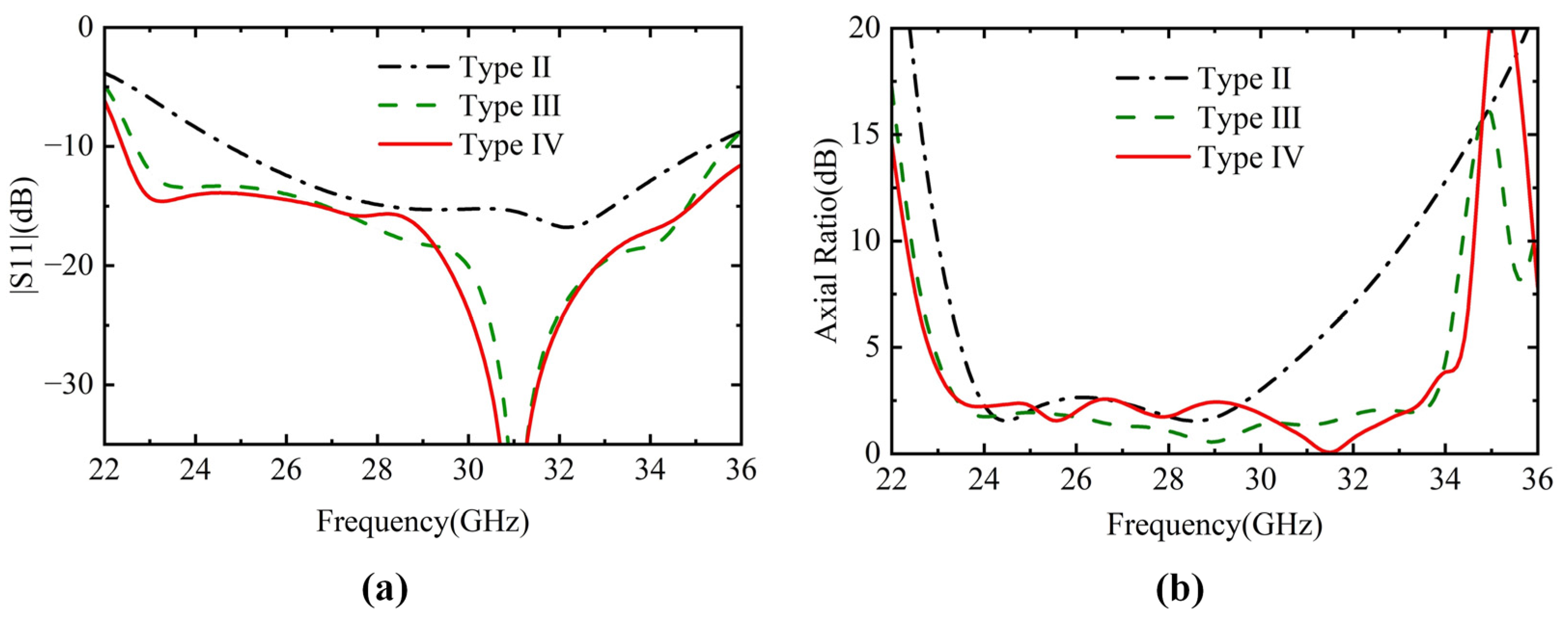

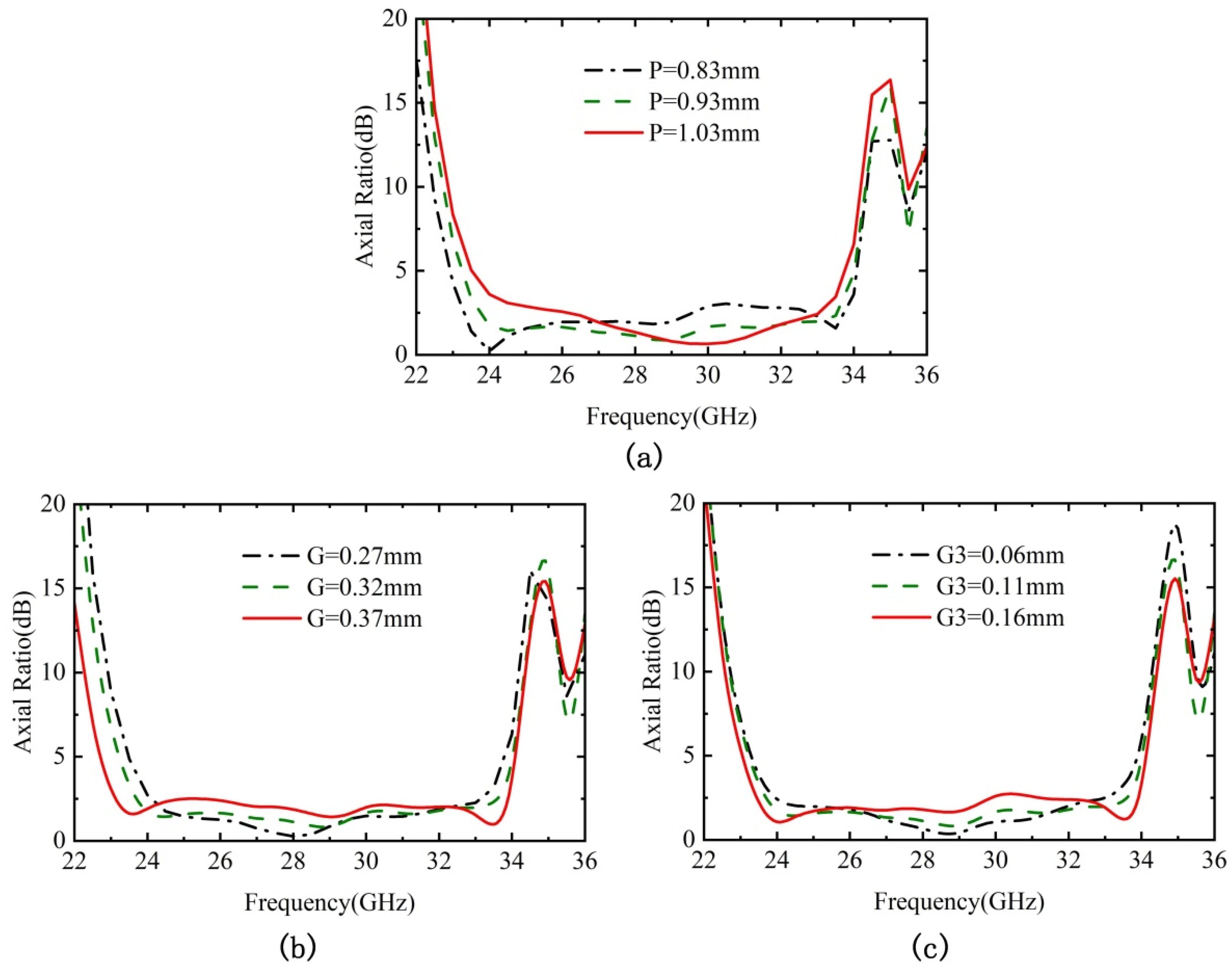

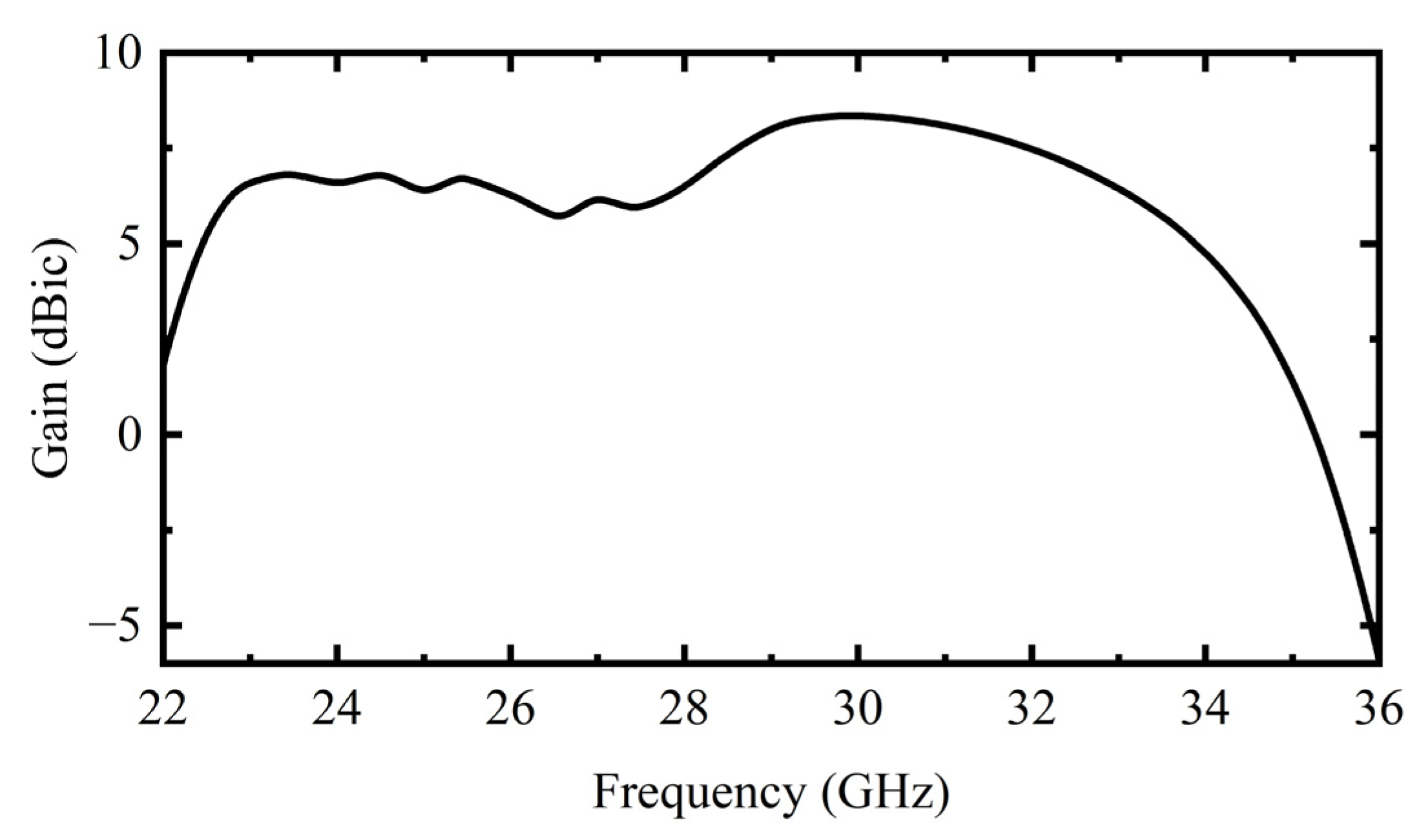


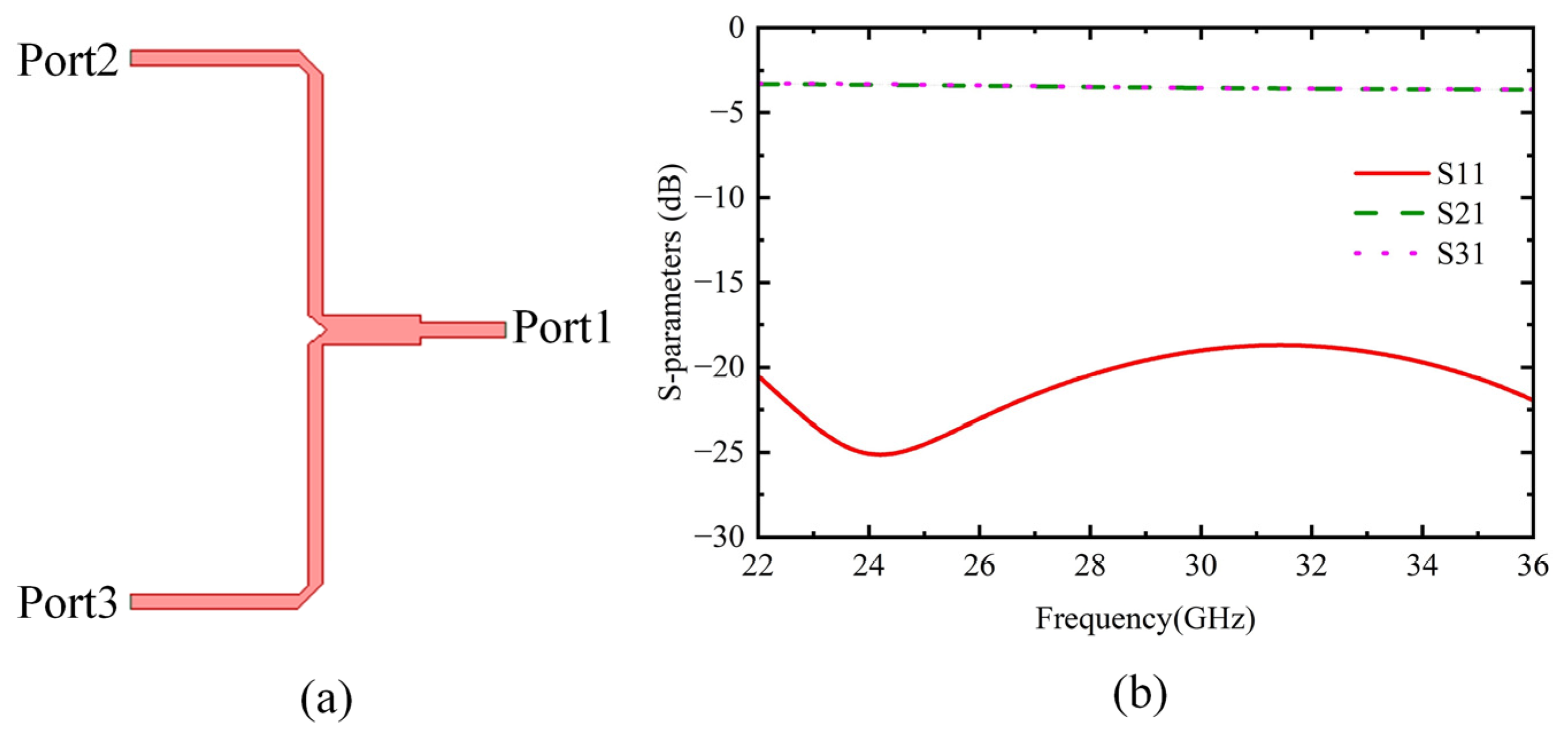

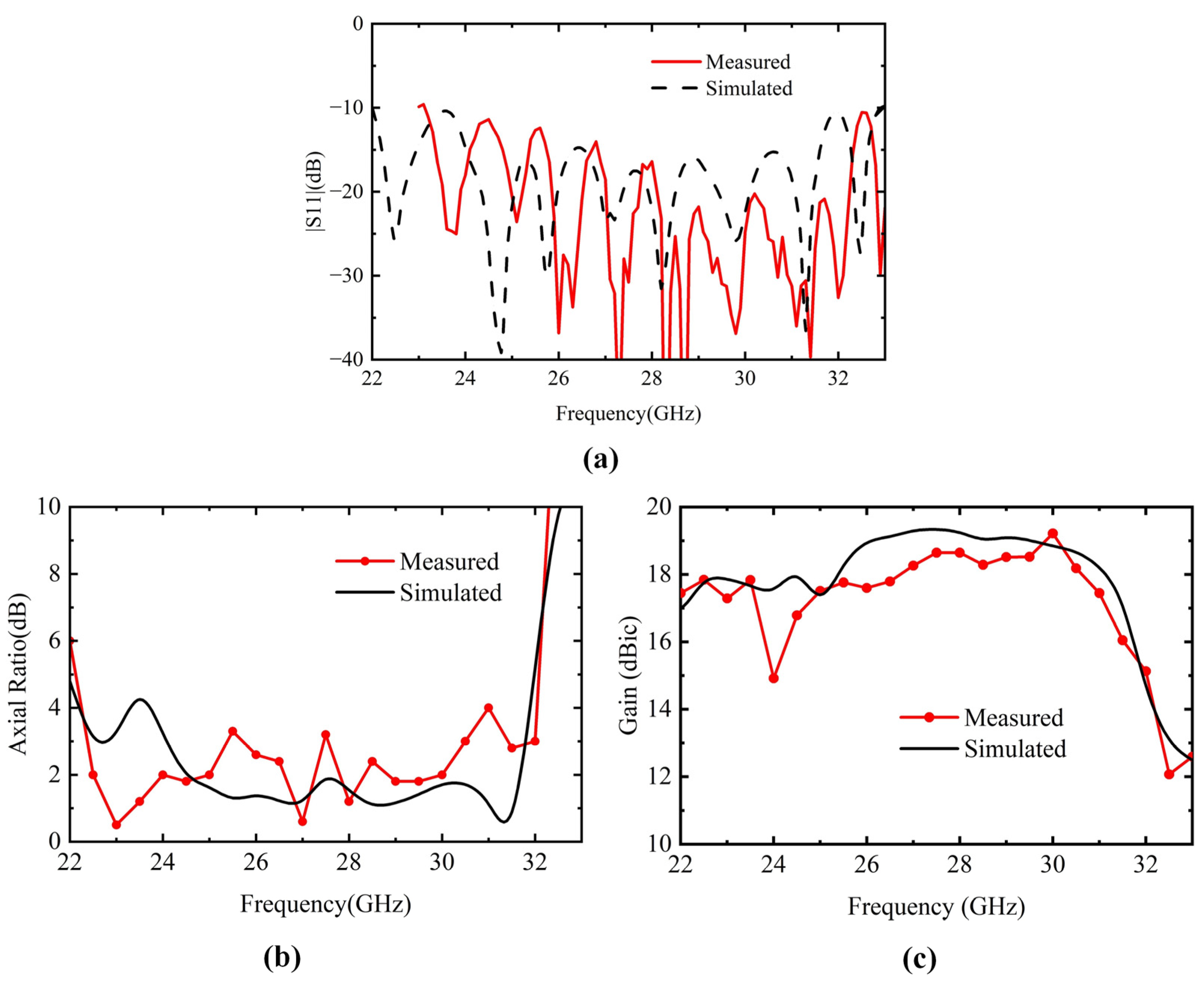

| Parameter | Value | Parameter | Value | Parameter | Value |
|---|---|---|---|---|---|
| L1 | 2.06 | G3 | 0.11 | S2 | 1.9 |
| L2 | 2 | D1 | 1.8 | P | 0.93 |
| L3 | 2.9 | D2 | 1.9 | Wf | 0.22 |
| L4 | 1.3 | D3 | 0.7 | Df | 0.49 |
| G1 | 0.32 | D4 | 4.1 | Ws | 0.36 |
| G2 | 0.32 | S1 | 2.35 | Ls | 3 |
| Ref. | Center Frequency (GHz) | No. of Substrate Layers | No. of Elements | Feeding Network | Impedance BW (%) | AR BW (%) | Peak Gain (dBic) | Size (λ0 × λ0 × λ0) |
|---|---|---|---|---|---|---|---|---|
| [5] | 29 | 2 | 4 × 4 | CPW + SIW | 29.6 | 25.4 | 20.32 | 10.2 × 8.7 × 0.098 |
| [6] | 28.35 | 4 | 4 × 4 | Microstrip line | 28.6 | 14 | 18.2 | 6.72 × 4.48 × 0.2 |
| [10] | 37.5 | 4 | 8 × 8 | SIW | 35.4 | 33.8 | 23.5 | 6 × 6 × 0.339 |
| [11] | 30 | 3 | 8 × 8 | SIW | 27.6 | 32.7 | 25.2 | 6.1 × 6.1 × 0.47 |
| [15] | 33.5 | 2 | 4 × 4 | SIW | 14.9 | 11 | 13.2 | 1.76 × 1.76 × 0.32 |
| [18] | 27.4 | 4 | 4 × 4 | Microstrip line + dual feed | 39.4 | 33.6 | 18.5 | 4.58 × 4.31 × 0.16 |
| [22] | 27 | 3 | 4 × 4 | CPW | 27.7 | 27.8 | 20.2 | 7 × 5 × 0.42 |
| [26] | 29.25 | 2 | 4 × 4 | Microstrip line | 58.46 | 13.68 | 14.69 | 5.2 × 5.2 × 0.08 |
| This Work | 28 | 2 | 4 × 4 | Microstrip line | 35.7 | 30.1 | 19.2 | 4.92 × 5.57 × 0.14 |
Disclaimer/Publisher’s Note: The statements, opinions and data contained in all publications are solely those of the individual author(s) and contributor(s) and not of MDPI and/or the editor(s). MDPI and/or the editor(s) disclaim responsibility for any injury to people or property resulting from any ideas, methods, instructions or products referred to in the content. |
© 2023 by the authors. Licensee MDPI, Basel, Switzerland. This article is an open access article distributed under the terms and conditions of the Creative Commons Attribution (CC BY) license (https://creativecommons.org/licenses/by/4.0/).
Share and Cite
Shi, B.; Cao, X.; Deng, C. Wideband Circularly Polarized Magneto-Electric Dipole Antenna Array with Metallic Walls for Millimeter-Wave Applications. Electronics 2023, 12, 2154. https://doi.org/10.3390/electronics12102154
Shi B, Cao X, Deng C. Wideband Circularly Polarized Magneto-Electric Dipole Antenna Array with Metallic Walls for Millimeter-Wave Applications. Electronics. 2023; 12(10):2154. https://doi.org/10.3390/electronics12102154
Chicago/Turabian StyleShi, Binlong, Xiaowei Cao, and Changjiang Deng. 2023. "Wideband Circularly Polarized Magneto-Electric Dipole Antenna Array with Metallic Walls for Millimeter-Wave Applications" Electronics 12, no. 10: 2154. https://doi.org/10.3390/electronics12102154
APA StyleShi, B., Cao, X., & Deng, C. (2023). Wideband Circularly Polarized Magneto-Electric Dipole Antenna Array with Metallic Walls for Millimeter-Wave Applications. Electronics, 12(10), 2154. https://doi.org/10.3390/electronics12102154






